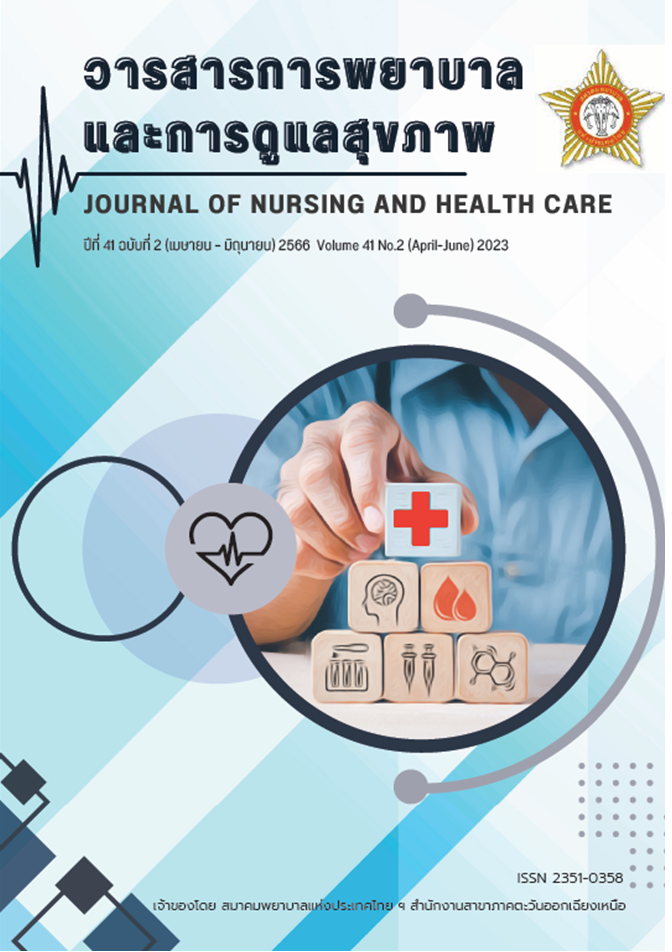การใช้หลักฐานเชิงประจักษ์เพื่อลดอาการปวดหลังในผู้ป่วยที่ทำการขยายหลอดเลือดปอดด้วยบอลลูน
คำสำคัญ:
การใช้หลักฐานเชิงประจักษ์, อาการปวดหลัง, การขยายหลอดเลือดปอดด้วยบอลลูน, การพยาบาลบทคัดย่อ
การขยายหลอดเลือดปอดด้วยบอลลูน เป็นหัตถการรักษาผู้ป่วยที่มีภาวะความดันหลอดเลือดปอดสูงจากลิ่มเลือดเรื้อรังอุดกั้นที่ไม่สามารถรักษาได้ด้วยการผ่าตัด โดยผู้ป่วยจะต้องได้รับการขยายหลอดเลือดปอดซ้ำหลายครั้งตลอดระยะการเจ็บป่วยในหัตถการดังกล่าวแพทย์จะแทงเข็มผ่านหลอดเลือดดำฟีมอรอล โดยขณะทำผู้ป่วยจะได้รับยาป้องกันการแข็งตัวของเลือด ทำให้เกิดภาวะแทรกซ้อนที่สำคัญภายหลังหัตถการคือ เลือดออกหรือเกิดก้อนเลือดใต้ผิวหนัง ผู้ป่วยจึงได้รับการดูแลให้นอนหงายราบห้ามงอขาที่ทำเป็นเวลา 6 ชั่วโมง เพื่อป้องกันภาวะแทรกซ้อน การนอนราบเป็นเวลานานส่งผลให้ผู้ป่วยเกิดอาการไม่สุขสบายจากการปวดหลังซ้ำ ๆ บทความนี้มีวัตถุประสงค์เพื่อทบทวนหลักฐานเชิงประจักษ์เพื่อใช้ในการจัดการอาการปวดหลังในผู้ป่วยหลัง การขยายหลอดเลือดปอดด้วยบอลลูน
ผลการทบทวนหลักฐานเชิงประจักษ์นำมาสู่การพัฒนาเป็นโปรแกรมการกระตุ้นให้ลุกเร็วในผู้ป่วยหลังการขยายหลอดเลือดปอดด้วยบอลลูน ใช้ในการดูแลภายหลังทำหัตถการจนครบ 4 ชั่วโมง ซึ่งกิจกรรมการดูแลประกอบไปด้วย การส่งเสริมการลุกเร็ว การปรับระดับหัวเตียง และการเปลี่ยนท่านอน จากการนำไปใช้ในการดูแลผู้ป่วย 2 ราย พบว่า ผู้ป่วยมีคะแนนความปวดลดลงเมื่อเทียบกับการทำครั้งก่อนหน้า รู้สึกสุขสบายมากขึ้น โดยไม่เกิดภาวะเลือดออกหรือก้อนเลือดใต้ผิวหนัง
Downloads
เอกสารอ้างอิง
Humbert M, Kovacs G, Hoeper MM, Badagliacca R, Berger RMF, Brida M, et al. 2022 ESC/ERS Guidelines for the diagnosis and treatment of pulmonary hypertension: Developed by the task force for the diagnosis and treatment of pulmonary hypertension of the European Society of Cardiology (ESC) and the European Respiratory Society (ERS). Endorsed by the International Society for Heart and Lung Transplantation (ISHLT) and the European Reference Network on rare respiratory diseases (ERN-LUNG). Eur Heart J. 2022;43(38):3618–731.
Puengpapat S, Pirompanich P. Incidence of chronic thromboembolic pulmonary hypertension in Thammasat University Hospital. Lung India Off Organ Indian Chest Soc. 2018;35(5):373–8. (in Thai)
Pussdhamma B. Pulmonary Hypertension and clinical cases. Khon Kaen: Faculty of medicine, Thailand; 2021.
Hoole SP, Coghlan JG, Cannon JE, Taboada D, Toshner M, Sheares K, et al. Balloon pulmonary angioplasty for inoperable chronic thromboembolic pulmonary hypertension: the UK experience. Open Heart. 2020;7(1):e001144.
Kjellstrom B, Ryftenius H, Landenfelt-Gestre LL, Ivarsson B. Outpatient specialist clinics for pulmonary arterial hypertension and chronic thromboembolic pulmonary hypertension in the Nordic countries. Pulm Circ. 2020;10(4):2045894019897499.
Cale R, Ferreira F, Pereira AR, Saraiva C, Santos A, Alegria S, et al. Balloon pulmonary angioplasty protocol in a Portuguese pulmonary hypertension expert center. Rev Port Cardiol. 2021;40(9):653–65.
Phuengsri K, Panyasuk S. Effects of care protocols after transfemoral coronary angiography, cardiac catheterization laboratory unit, Lampang Hospital. Journal of Health Science. 2019;28(6):1077–91. (in Thai)
Hilario TS, Santos SM, Kruger J, Goes MG, Casco MF, Rabelo-Silva ER. Pain assessment and management in patients undergoing endovascular procedures in the catheterization laboratory. Rev Esc Enferm USP [Internet]. 2017 [cited 2022 Sep 2]. Available from: http://www.scielo.br/j/reeusp/a/XTSp8rVcfhKdFLBhbxDNMSx/?lang=en
Piva CD, Vaz E, Moraes MA, Goldmeyer S, da Costa Linch GF, de Souza EN. Discomfort reported by patients after cardiac catheterization using the femoral or radial approaches. Rev Bras Cardiol Invasiva Engl Ed. 2014;22(1):36–40.
van Thor MCJ, Lely RJ, Braams NJ, ten Klooster L, Beijk MAM, Heijmen RH, et al. Safety and efficacy of balloon pulmonary angioplasty in chronic thromboembolic pulmonary hypertension in the Netherlands. Neth Heart J. 2020;28(2):81–8.
Melzack R, Wall PD. Pain mechanisms: a new theory. Science 1965; 150(3699):971-9.
Siegele DS. Pain and suffering: the gate control theory. Am J Nurs 1974; 74(3):498- 502.
Chaiyagad C, Ruaisungnoen W. Back pain management for patients underwent transfemoral coronary angiography: nurse’s role. Srinagarind Med J. 2021;36(1):111-8. (in Thai).
Leaungsomnapa, S, Ngamkham, S. Attention to pain. The Journal of Prapokklao Hospital Clinical Medical Education Center. 2013;30(1):83–93. (in Thai)
Kobrossi S, Tamim H, Dakik HA. Vascular complications of early (3h) vs standard (6h) ambulation post-cardiac catheterization or percutaneous coronary intervention from the femoral artery. Int J Cardiol. 2014; 176(3):1067–9.
Burn KL, Marshall B, Scrymgeour G. Early mobilization after femoral approach diagnostic coronary angiography to reduce back pain. J Radiol Nurs. 2015;34(3):162–9.
Cha NH, Sok S. Effects of position change on lumbar pain and discomfort of Korean patients after invasive percutaneous coronary intervention: a RCT study. J Phys Ther Sci. 2016;28(10):2742–7.
Fereidouni Z, Morandini MK, Kalyani MN. The efficacy of interventions for back pain in patients after transfemoral coronary angiography: A rapid systematic review. J Vasc Nurs. 2019;37(1):52–7.
Turen S, Yilmaz RA, Yesiltepe N, Bektas I. Effect of the head of bed elevation on back pain after elective coronary angiography: A randomized controlled trial. Appl Nurs Res. 2022;64:151571.
ดาวน์โหลด
เผยแพร่แล้ว
รูปแบบการอ้างอิง
ฉบับ
ประเภทบทความ
สัญญาอนุญาต
ลิขสิทธิ์ (c) 2023 วารสารการพยาบาลและการดูแลสุขภาพ

อนุญาตภายใต้เงื่อนไข Creative Commons Attribution-NonCommercial-NoDerivatives 4.0 International License.



